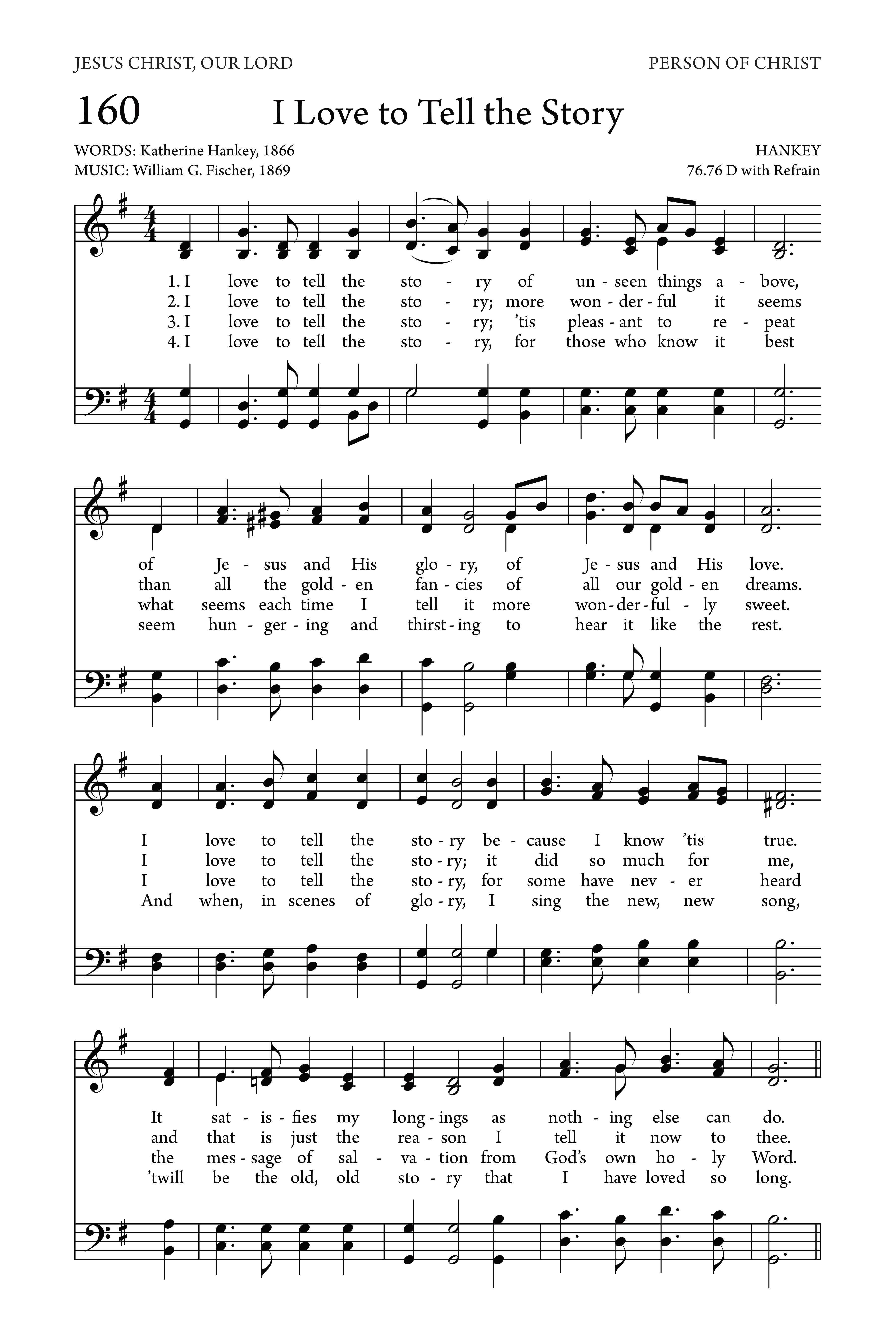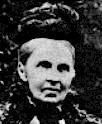I Love to Tell the Story
By Kate Hankey
Lyrics
of unseen things above,
of Jesus and His glory,
of Jesus and His love.
I love to tell the story
because I know it's true.
it satisfies my longings
as nothing else can do.
I love to tell the story!
'Twill be my theme in glory
to tell the old, old story
of Jesus and His love.
more wonderful it seems
than all the golden fancies
of all our golden dreams.
I love to tell the story;
it did so much for me,
and that is just the reason
I tell it now to thee.
'tis pleasant to repeat
what seems, each time I tell it
more wonderfully sweet.
I love to tell the story;
for some have never heard
the message of salvation
from God's own holy Word.
for those who know it best
seem hungering and thirsting
to hear it like the rest.
And when in scenes of glory
I sing the new, new song,
'twill be the old, old story
that I have loved so long.
Bible Reference
Proverbs 11:30
About This Hymn
“I Love to Tell the Story” is one of the enduring hymns that grew out of the rich evangelical heritage of 19th-century England. The hymn text was written by A. Katherine Hankey (1834–1911), while the tune most commonly associated with it was composed by William G. Fischer (1835–1912). The hymn is set in a 13.7.6.13.7.6 meter with a refrain, and it beautifully reflects the spirit of Christian evangelism, echoing Proverbs 11:30 (KJV): “The fruit of the righteous is a tree of life; and he that winneth souls is wise.” Its roots lie deep in the history of the evangelical revival that began in England during the mid-18th century under the leadership of men like George Whitefield and John and Charles Wesley. While this movement initially attracted mostly the working and middle classes, the 19th century saw a notable shift as the message began to influence the upper classes of British society.
One influential group among the British elite was the Clapham Sect, a network of wealthy, Bible-believing Anglican laypeople known for their evangelical zeal, philanthropic spirit, and deep personal commitment to Christian service. Operating from the affluent suburb of Clapham in Southwest London, members of this group—many of whom served in Parliament—devoted themselves to social reform and evangelism, seeking to alleviate suffering among the poor and bring the Gospel to all corners of society. While maintaining their ties to the Anglican Church, they emphasized personal conversion and the work of the Holy Spirit over formal rituals and sacraments. A prominent historian once remarked, “Never in the history of Anglicanism had any group exercised so profound an influence,” attesting to the enduring spiritual legacy of the Clapham Sect.
Katherine Hankey, affectionately known as "Kate," was born in 1834 into this same environment of spiritual fervor and social conscience. Her father, a successful banker, was an active member of the Clapham Sect, and he instilled in her from an early age a passion for the Gospel and concern for the spiritual well-being of others. Despite their privileged social standing, the Hankey family’s faith was deeply evangelical in character. Following in this tradition, young Kate began organizing Sunday school classes across London, both for the rich and the poor. These classes had a significant spiritual impact, nurturing young believers, many of whom became committed Christian workers themselves. Kate also authored a variety of religious writings, including Bible Class Teachings, a guide on confirmation, and several books of sacred verse. All proceeds from her publications were dedicated to foreign mission efforts, demonstrating her selfless dedication to the global spread of the Gospel.
At the age of thirty, Katherine Hankey fell seriously ill and was confined to bed for a prolonged period. During her convalescence, she composed a long narrative poem on the life of Christ, divided into two major parts—“The Story Wanted” and “The Story Told”—each consisting of fifty verses. From the first part of this poem came the popular children’s hymn “Tell Me the Old, Old Story.” Later, while still recovering, she completed the second half of the poem, which eventually became the source for “I Love to Tell the Story.” Although both texts were originally set to music by Hankey herself, they received little attention at the time due to the limited appeal of her compositions. Nevertheless, her words were destined for greater use.
A pivotal moment came in 1867, when a large international YMCA convention was held in Montreal, Canada. Among the featured speakers was Major General Russell of England, who concluded his moving address by reciting verses from Kate Hankey’s two hymns. In the audience was William H. Doane, a prominent American gospel composer known for his prolific output of more than 2,000 songs. Deeply moved by the beauty and spiritual clarity of Hankey’s poetry, Doane quickly composed new musical settings for both texts, bringing fresh life to the hymns and helping them reach a broader audience.
Not long after, another American composer, William G. Fischer, provided an alternative setting for “I Love to Tell the Story,” which eventually supplanted Doane’s version. Fischer’s tune, combined with the addition of the now-famous refrain—“I love to tell the story! ’Twill be my theme in glory—to tell the old, old story of Jesus and His love”—gave the hymn its final and most beloved form. This version was first published in 1875 in the influential Gospel Hymns and Sacred Songs compiled by Philip P. Bliss and Ira D. Sankey, two of the foremost figures in the American gospel music revival. Their collection brought the hymn into widespread use in evangelical congregations around the world.
Today, “I Love to Tell the Story” remains a cherished hymn, known for its personal tone, theological clarity, and strong evangelistic appeal. It speaks not just of telling the Gospel to others, but of loving to tell it—a testimony to the deep personal joy found in proclaiming Christ. Like many of the best hymns of the 19th century, it blends doctrinal truth with emotional sincerity, drawing from a life of genuine faith and service. It continues to be sung across denominations, especially in evangelistic settings, missionary services, and church gatherings focused on outreach and testimony.
In both content and history, “I Love to Tell the Story” reflects the heart of the evangelical movement—a deep love for Scripture, a personal relationship with Jesus, and a burning desire to share the good news of salvation. From the Clapham Sect’s drawing rooms in London to the revival tents of America, the message remains unchanged: the old, old story of Jesus and His love is ever new, ever powerful, and always worth telling.


📬 Subscribe to Our Devotional Updates
Receive weekly hymns, devotionals, and website features directly in your inbox.
Hymn Information

- Category: Hymn
- Author/Writer: Kate Hankey (1866)
- Added: June 19, 2025
- Last Updated: June 19, 2025
- Views: 1356
MIDI File
More Hymns by Kate Hankey
Recent Blog Posts
-

-
 Is Faith Blind?
Is Faith Blind?
Dec 05, 2025 -
 What Is True Worship?
What Is True Worship?
Dec 05, 2025 -
 Can Christians Date Non-Believers?
Can Christians Date Non-Believers?
Dec 05, 2025 -
 How Do I Study the Bible Effectively?
How Do I Study the Bible Effectively?
Dec 05, 2025
Visit Us on Social Media
Latest from X (Twitter)
Tweets by HymnalLibraryLatest from Facebook
Latest on YouTube
Daily Bible Verse
Disclaimer
The hymns, sheet music, MIDI files, and related content on this website are provided for educational and research purposes only.
- Public Domain: Many of the hymns featured here are in the public domain and may be freely used.
- Copyrighted Works: Some hymns may still be under copyright protection. Where applicable, permission has either been requested from the copyright owner, or the content is shared under the principles of fair use for educational purposes.
⚠️ Important Notice: If you wish to reproduce, distribute, or use any copyrighted hymn beyond personal study or educational use, you must obtain permission directly from the copyright holder. This website does not grant any rights for commercial use yet.
If there is any other question please address it to us in our Contact Page, for further assistance. Thank you for using the site. May God Bless You.